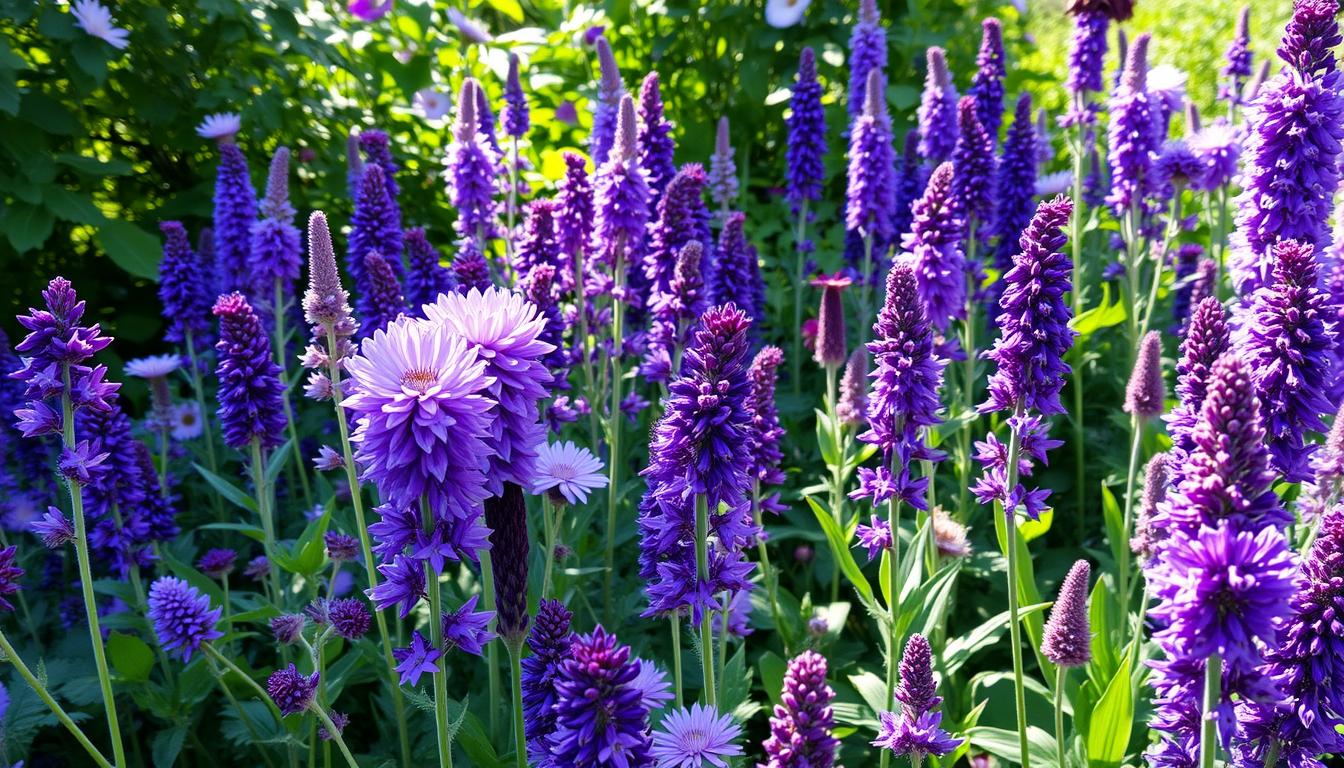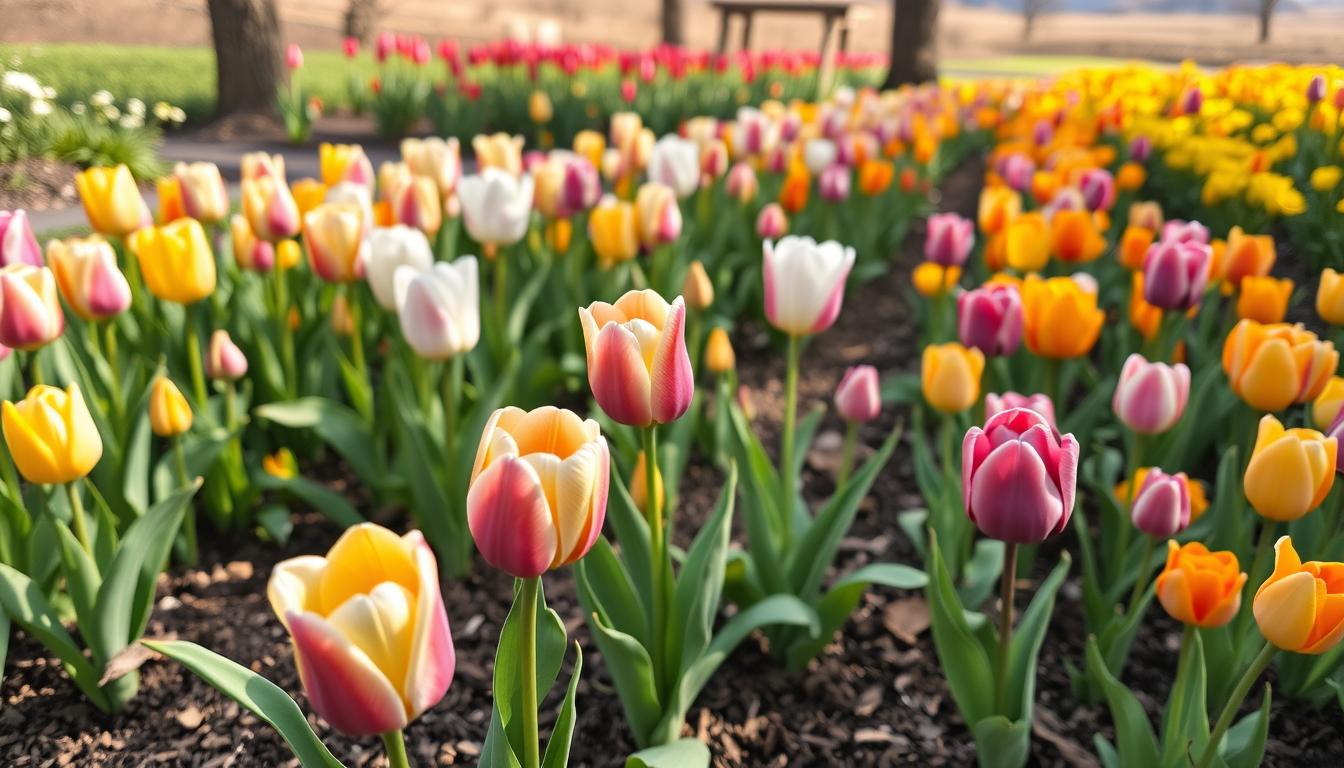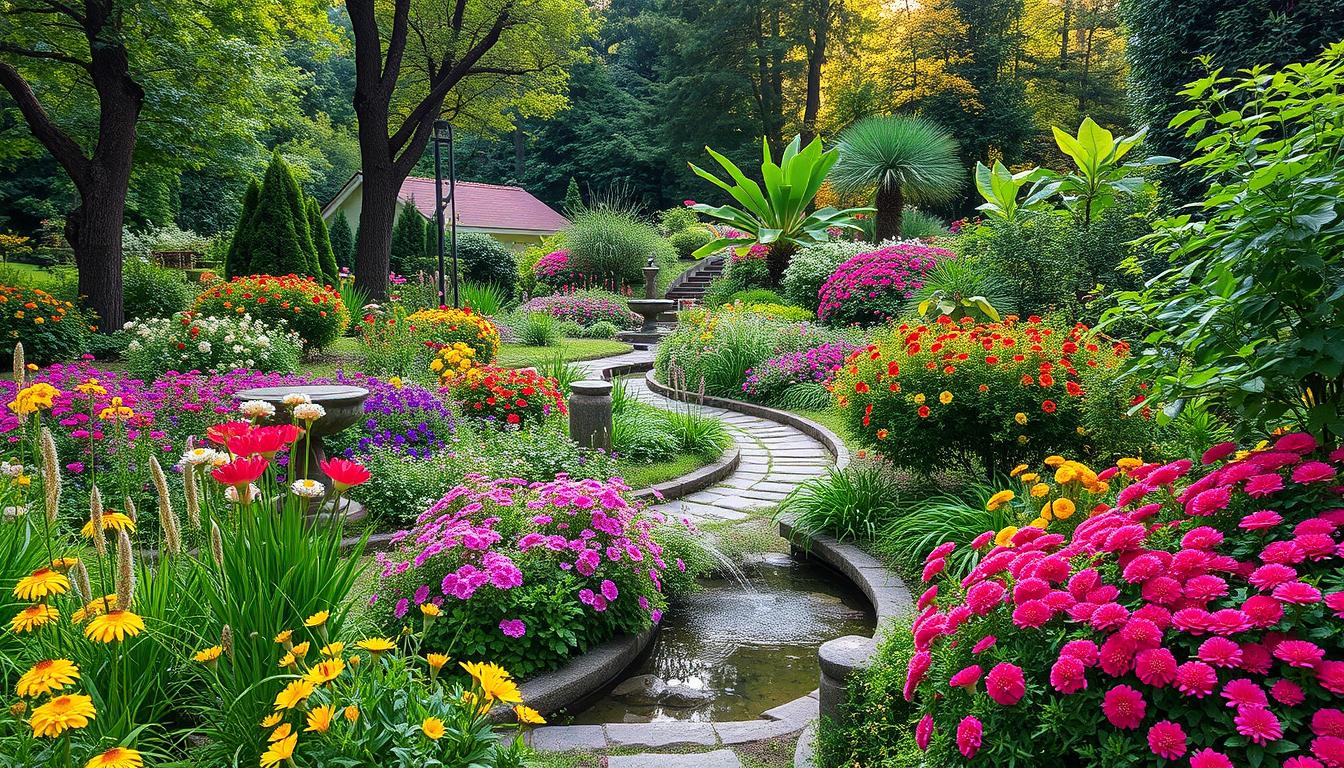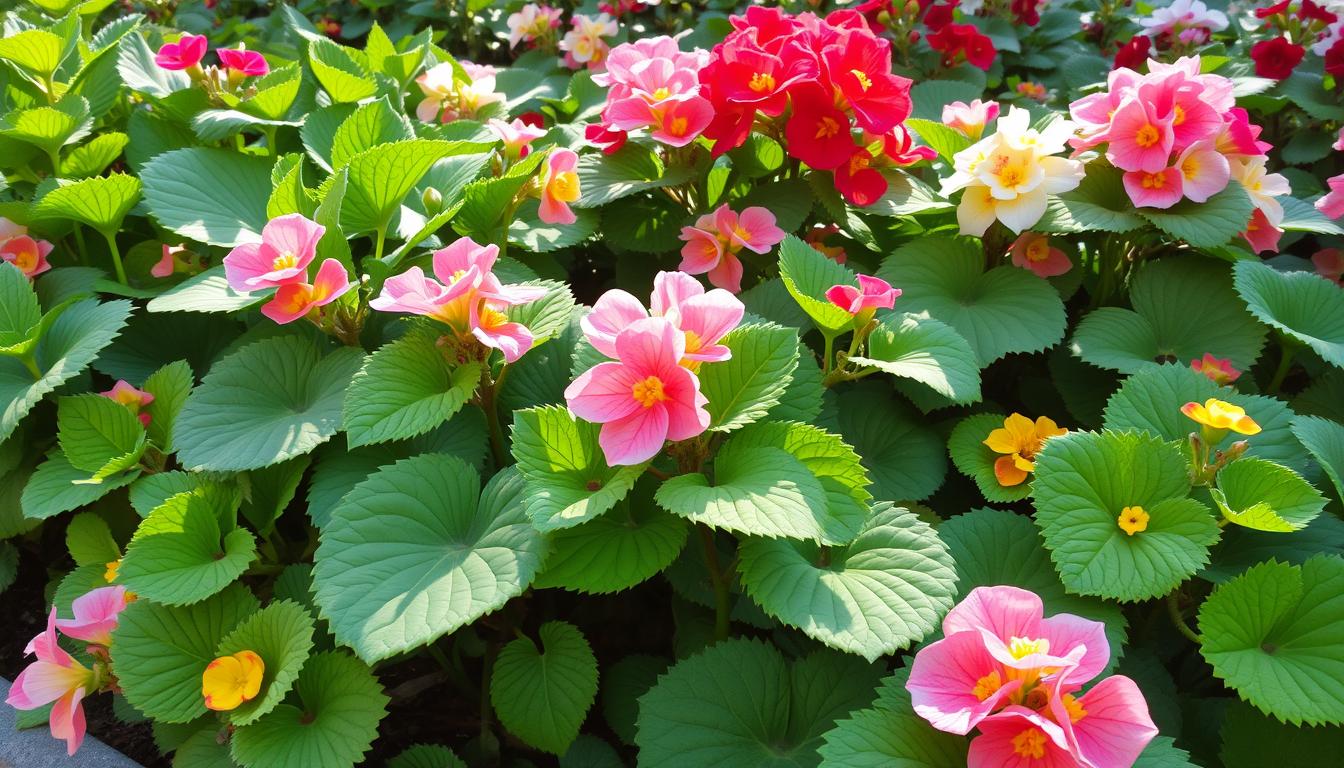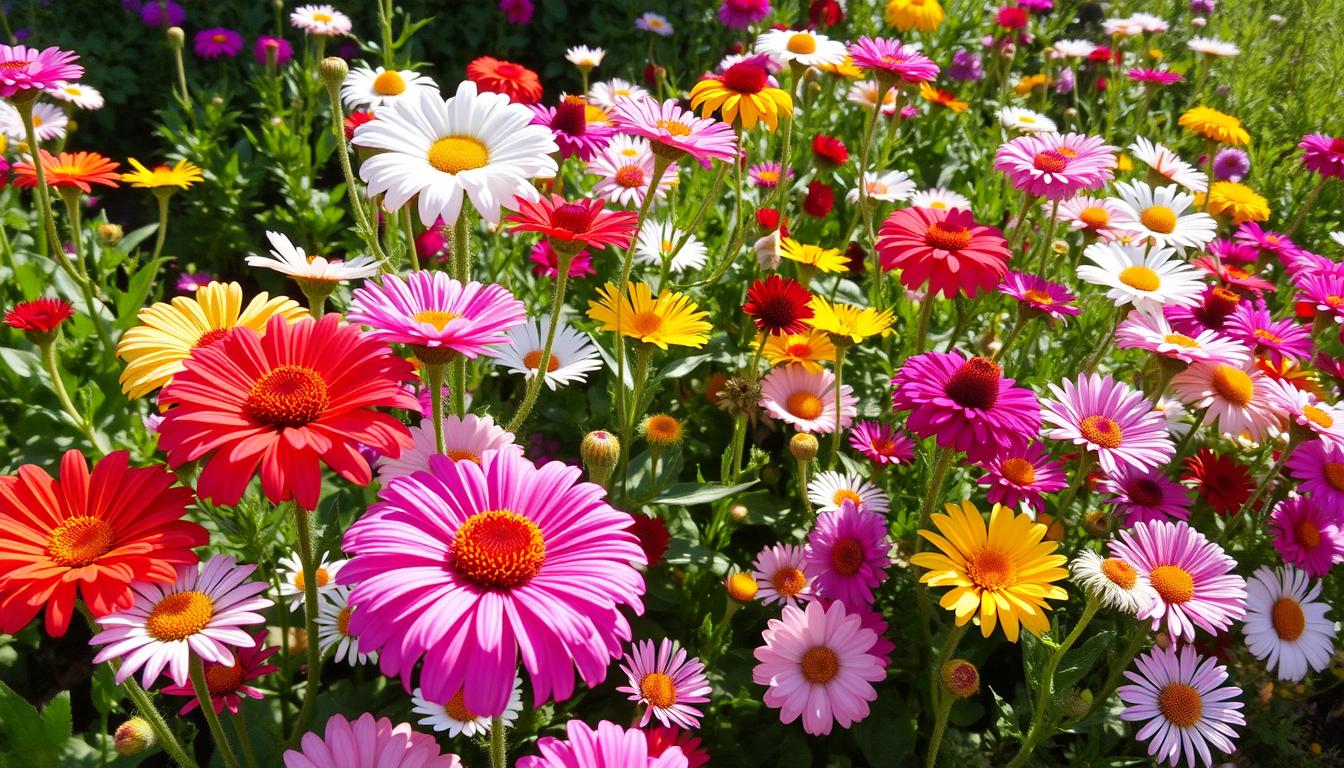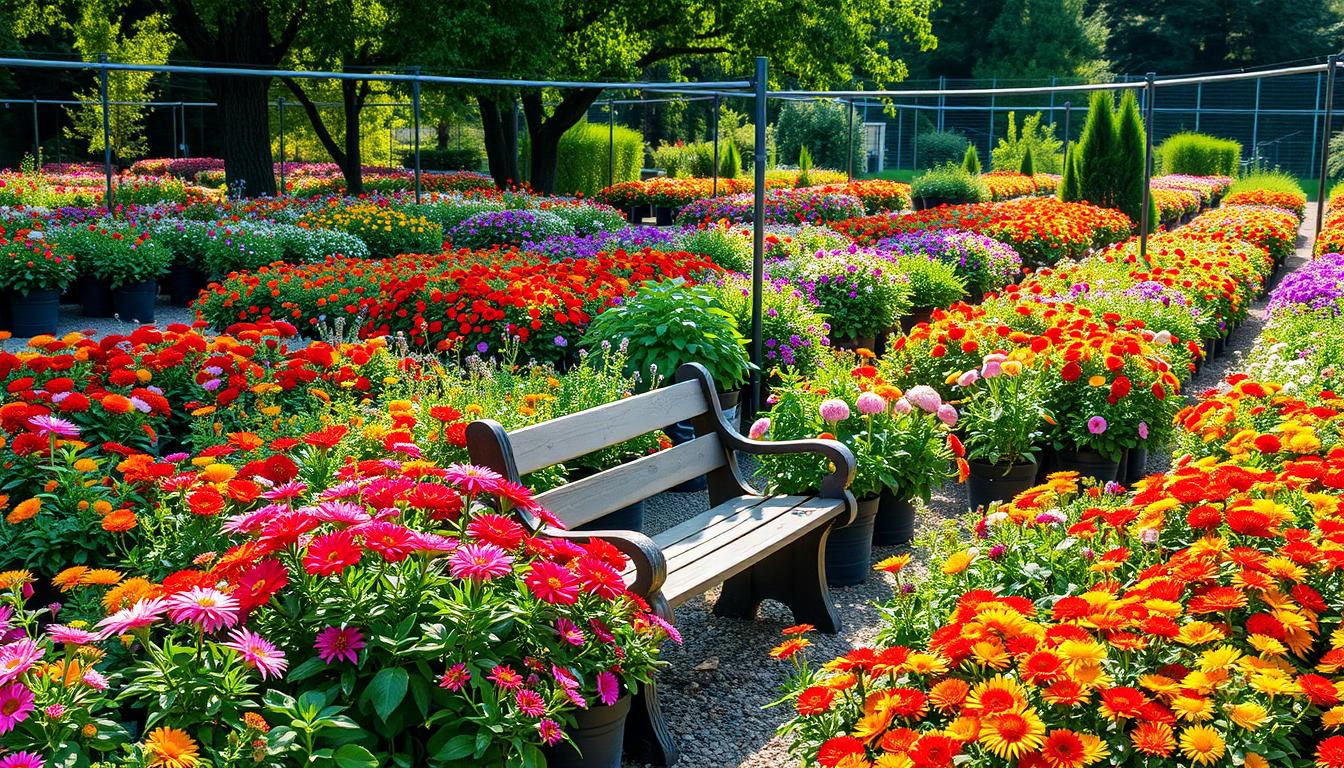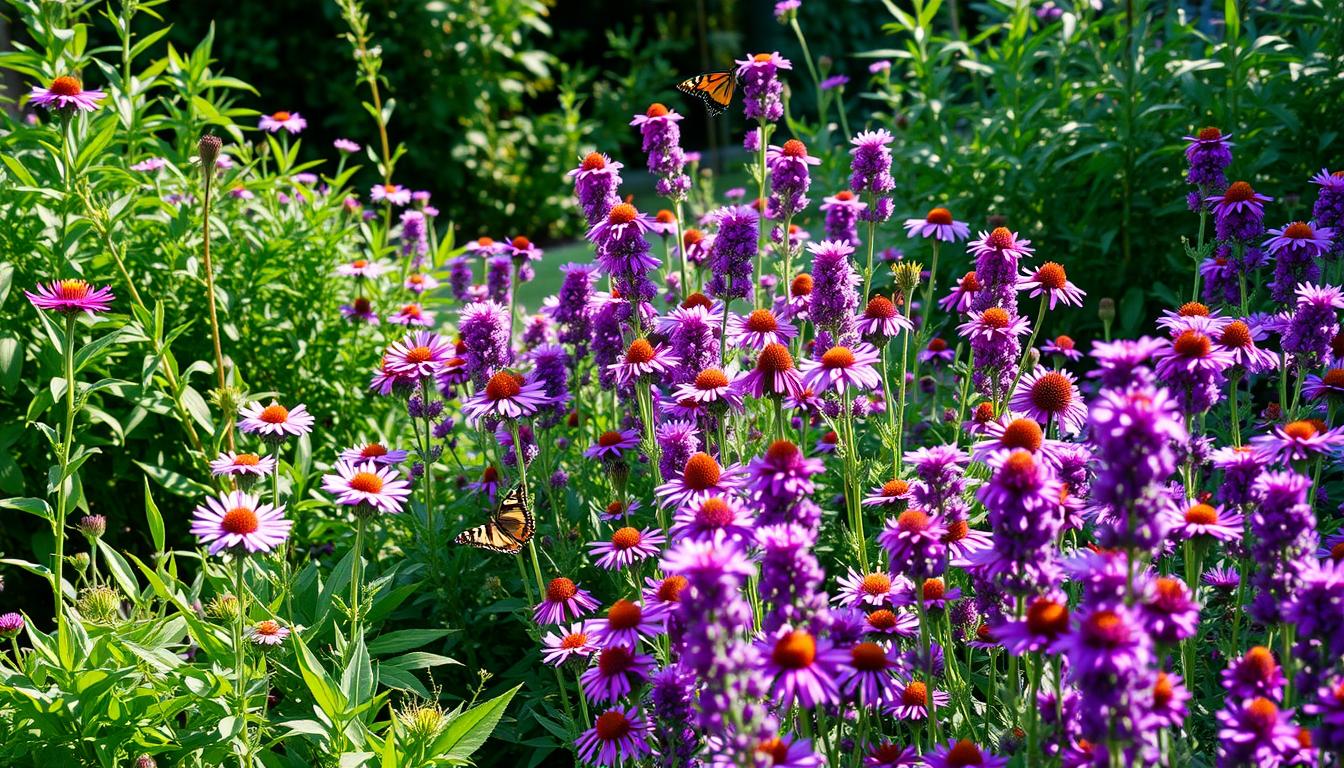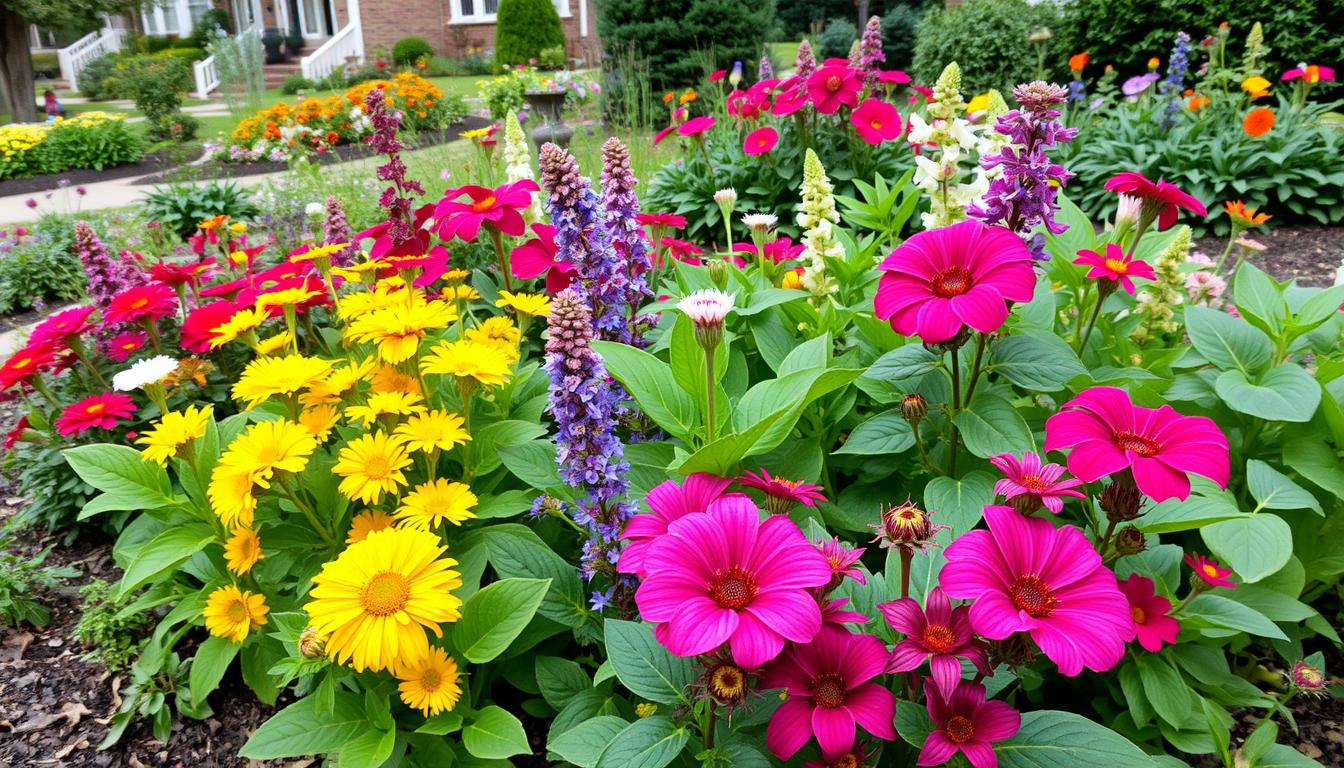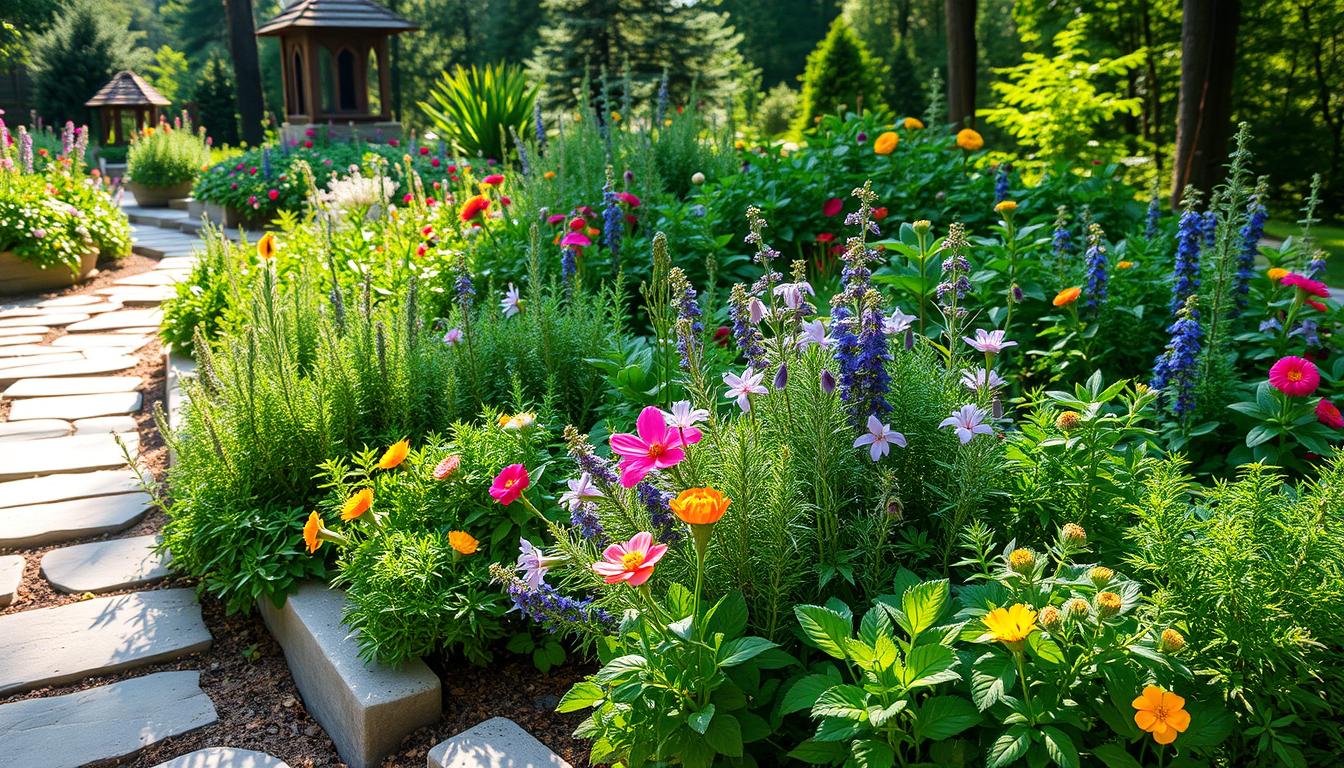Are Hollyhocks Perennials? Ever thought about hollyhocks making your garden bloom every year? These flowers stand tall and bright, making gardeners curious about their growth and life span.
Are hollyhocks perennials or annuals? It’s not a simple yes or no. Different types of hollyhocks have their own traits, surprising even seasoned gardeners. Knowing how they grow can make your garden a stunning sight.
This guide dives into the world of hollyhocks, uncovering their secrets. It’s perfect for both new and experienced gardeners. You’ll learn all about hollyhocks, whether they’re perennials or annuals.
Ready to uncover the magic of these flowers? Learn how to grow a garden that will wow your neighbors!
Table of Contents
Understanding Hollyhocks and Their Growth Patterns
Hollyhocks are amazing plants that grab the attention of gardeners. They stand tall and show off vibrant flowers. These plants grow in unique ways, making them stand out.
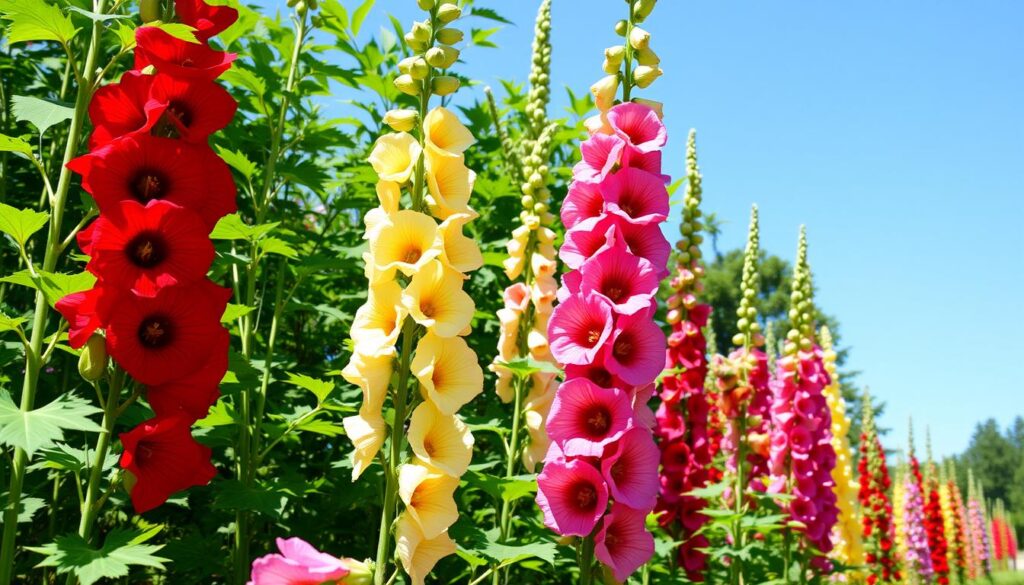
Growing hollyhocks is interesting because of their life cycle. They are biennials, which means they grow fully in two years. This makes them special in the gardening world.
The Life Cycle of Hollyhocks
- First year: Plants develop roots and foliage
- Second year: Full flowering and seed production
- Self-seeding capability enables continuous growth
Annual vs. Perennial Plants
Knowing the difference between annual and perennial plants is key. Hollyhocks are technically biennials but act like perennials. This is because they self-seed well.
| Plant Type | Lifecycle | Hollyhock Behavior |
|---|---|---|
| Annual | One growing season | Limited application |
| Biennial | Two growing seasons | Primary classification |
| Perennial | Multiple years | Resembles through self-seeding |
Characteristics of Hollyhocks
Hollyhocks are known for their impressive traits. They grow 4 to 8 feet tall, with flower stalks that can have over 100 blooms. They love full sun and well-drained soil with a pH of 6.0 to 7.0.
“Hollyhocks are the skyscrapers of the garden, reaching impressive heights and creating dramatic visual impact.” – Garden Enthusiast Magazine
With 30 known species, hollyhocks offer many options for stunning gardens. They have a 70-90% germination rate, making them reliable for gardeners.
Are Hollyhocks Perennials or Annuals?
Gardeners often wonder if hollyhocks are perennials or annuals. The truth is, hollyhocks can be both, depending on the conditions they grow in.
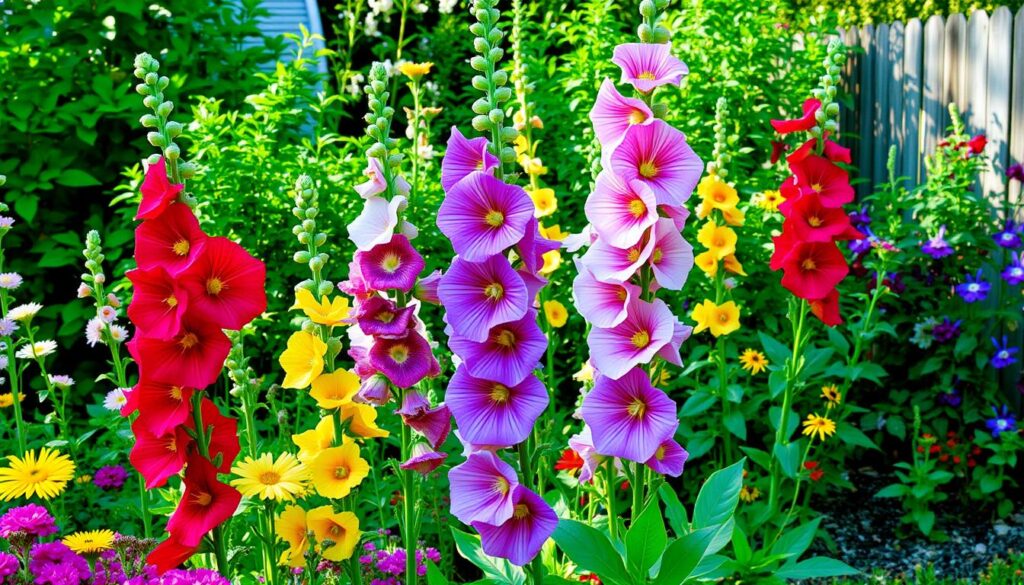
To understand hollyhocks, we need to clear up some common myths. They are not just simple perennials or annuals. Instead, they fit into a more complex category.
Unraveling Hollyhock Growth Mysteries
Hollyhocks are often seen as short-lived perennials or biennials. Their growth pattern can be quite unpredictable. Whether they act as perennials depends on several factors:
- Climate zone
- Specific variety
- Garden care
- Growing conditions
The Perennial Potential of Hollyhocks
Some hollyhock varieties can be true perennials in the right conditions. These special types can come back year after year. They offer stunning vertical displays in gardens.
| Hollyhock Type | Perennial Potential | Typical Lifespan |
|---|---|---|
| Alcea rosea (Common Hollyhock) | Short-lived perennial | 2-3 years |
| Perennial Hollyhock Varieties | True perennial | 3-5 years |
| Biennial Types | Limited perennial behavior | 1-2 years |
“Hollyhocks are garden chameleons – adapting to their environment with remarkable resilience.” – Professional Gardener
To figure out if your hollyhocks are perennials, look at your growing zone and the type you planted. With the right care, many hollyhocks can act like perennials. They will come back to brighten your garden with their beautiful blooms.
Types of Hollyhocks to Consider
Exploring hollyhock varieties can turn your garden into a vibrant botanical showcase. These stunning flowers offer a wide range of options. They suit different landscape designs and personal preferences.
Gardeners love hollyhock varieties for their remarkable diversity. Each type has unique characteristics. They can elevate your outdoor space with stunning visual appeal.
Popular Hollyhock Cultivars
- Chater’s Double Series: Known for lush, ruffled blooms in multiple colors
- Indian Spring Mix: Features single flowers in soft pastel shades
- Nigra Variety: Dramatic dark burgundy to almost black flowers
- Queeny Purple: Compact plants with deep purple blossoms
Unique Features of Different Hollyhock Types
When selecting hollyhock varieties, consider these distinctive traits:
- Height ranges from 12 to 30 inches
- Bloom times spanning early to late summer
- Color variations including white, pink, yellow, and deep burgundy
“Choose hollyhock varieties that complement your garden’s existing color palette and design aesthetic.”
Your hollyhock selection can dramatically impact your garden’s visual appeal. Some varieties work brilliantly in cottage gardens. Others shine in more structured landscape designs.
Considerations for Choosing Hollyhock Varieties
Consider your hardiness zone (3-9) when selecting hollyhock varieties. Different types thrive in specific climate conditions. This ensures successful growth and beautiful blooms throughout the summer season.
Ideal Growing Conditions for Hollyhocks
Growing hollyhocks needs knowing their special needs. These beautiful plants do best in certain conditions. To care for them well, gardeners must think about a few important things.
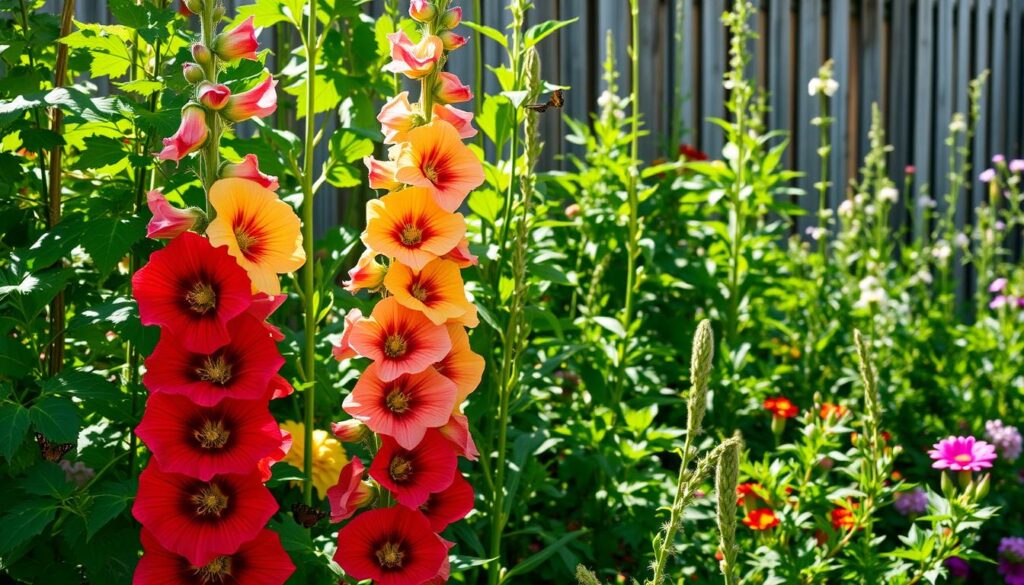
Sunlight and Soil Requirements
Hollyhocks love full sun to grow well. They do best in zones 3-10. The best conditions include:
- Minimum 6-8 hours of direct sunlight daily
- Well-draining, rich organic soil
- Soil pH between 6.0 and 7.5
Pro tip: Prepare your garden bed by adding compost to improve soil quality and drainage for robust hollyhock growth.
Watering Needs
Watering hollyhocks right is key. They need steady moisture but not too much. Water deeply but not too often, letting the soil dry a bit between waterings.
“Consistent moisture is the key to healthy hollyhocks” – Garden Experts
Seasonal Considerations
Knowing about seasonal changes is important for hollyhocks. Different zones need different plans:
- Zones 3-6: Start seeds indoors in February
- Zones 7-10: Can direct sow or transplant earlier
- Ideal nighttime temperature: Around 65°F
With the right conditions, you can see hollyhocks bloom from July to October. They make your garden look amazing.
Planting Hollyhocks Successfully
Growing beautiful hollyhocks needs careful planning and attention. When you’re ready to add these stunning flowers to your garden, knowing the right planting techniques is key. Gardening experts recommend following specific guidelines for optimal hollyhock cultivation.
Best Time to Plant Hollyhocks
Timing is crucial when planting hollyhocks. The best time is spring, from February 17 to June 6, depending on your hardiness zone. Hollyhocks thrive in zones 3-10, making them versatile garden additions.
- Spring planting allows roots to establish before summer heat
- Recommended planting depth: 2 inches
- Best performed in full sun locations
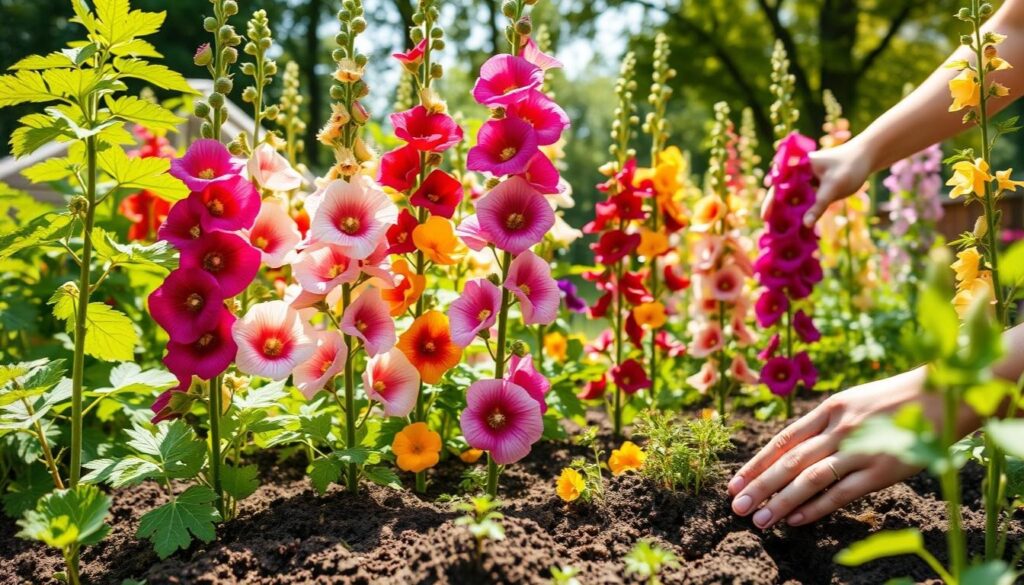
Spacing and Arrangement Tips
Proper spacing is key for healthy hollyhock growth. Hollyhock planting tips suggest spacing plants 24 inches apart. This ensures adequate air circulation and room for development. These magnificent flowers can reach an impressive average height of 44 inches, creating dramatic garden backdrops.
“Winter sowing allows for minimal investment in time and materials” – Gardening Wisdom
| Planting Characteristic | Recommendation |
|---|---|
| Spacing | 24 inches apart |
| Planting Depth | 2 inches |
| Light Requirement | Full Sun |
Remember, experimenting with new seeds each year can help you find the most successful varieties for your garden. With proper care and attention, your hollyhocks will bloom magnificently from midsummer until the first frost.
Caring for Your Hollyhocks
Successful hollyhock care needs attention and knowing what your plants need. Keeping these beautiful plants healthy involves several important steps. These steps help them grow well and bloom beautifully all summer.
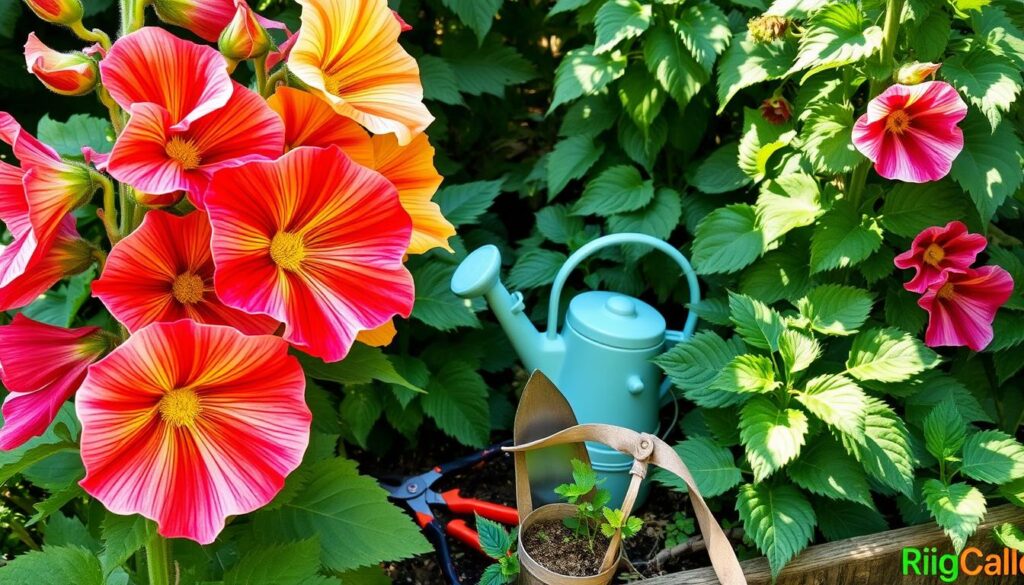
Fertilizing Guidelines
Proper fertilization is key for strong hollyhock plants. Choose a balanced, slow-release fertilizer with equal parts nitrogen, phosphorus, and potassium. Put fertilizer on in early spring when new growth starts. Then, repeat every six weeks during the growing season.
- Use organic compost to enrich soil nutrients
- Avoid over-fertilizing, which can reduce flower production
- Select fertilizers with an NPK ratio of 5-10-5
Pruning and Deadheading Techniques
Pruning is important for hollyhock care to keep them blooming. Deadhead spent flowers by cutting them back to the first set of healthy leaves. This stops seed formation and encourages more flowers.
“Pruning is an art that transforms your hollyhocks from ordinary to extraordinary.” – Garden Experts
Dealing with Pests and Diseases
Good hollyhock care means watching for common problems like rust, Japanese beetles, and spider mites. Check your plants often and act fast if you see any issues.
- Remove infected leaves promptly
- Use neem oil for natural pest control
- Maintain proper air circulation between plants
By following these care tips, your hollyhocks will stay healthy, vibrant, and be a beautiful garden highlight all season.
Attracting Pollinators with Hollyhocks
Hollyhock flowers are a natural welcome for pollinators. These plants make your garden a vibrant home for butterflies, bees, and more. By growing these flowers, you can turn your garden into a haven for pollinators.
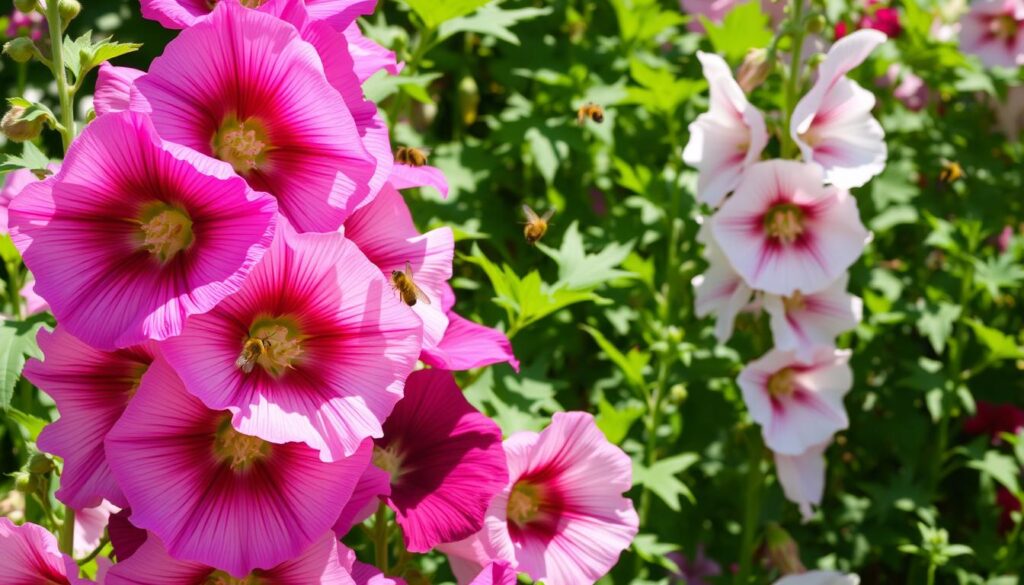
Pollinators love hollyhocks for many reasons. Their tall, colorful stalks are a beacon for insects looking for nectar and pollen. Creating a butterfly-friendly garden means choosing plants that are both beautiful and nourishing.
Why Pollinators Love Hollyhocks
- Abundant nectar production
- Large, open flower structures
- Bright, attractive colors
- Extended blooming periods
How to Create a Pollinator-Friendly Garden
To make your hollyhock flowers more appealing to pollinators, follow these tips:
- Plant hollyhocks in sun-drenched areas
- Group flowers in clusters for maximum visibility
- Avoid using chemical pesticides
- Provide nearby water sources
| Pollinator Type | Attraction to Hollyhocks | Blooming Period |
|---|---|---|
| Butterflies | High | Summer to Early Fall |
| Bees | Moderate to High | Mid-Summer to Fall |
| Hummingbirds | Moderate | Late Summer |
“A garden without pollinators is like a symphony without music” – Unknown Gardener
By adding hollyhock flowers to your garden, you’ll create a lively space. It will support local wildlife and look beautiful.
Companion Plants for Hollyhocks
Choosing the right plants to grow with hollyhocks can make your garden look amazing. Companion planting adds beauty, helps plants stay healthy, and makes your garden more productive.
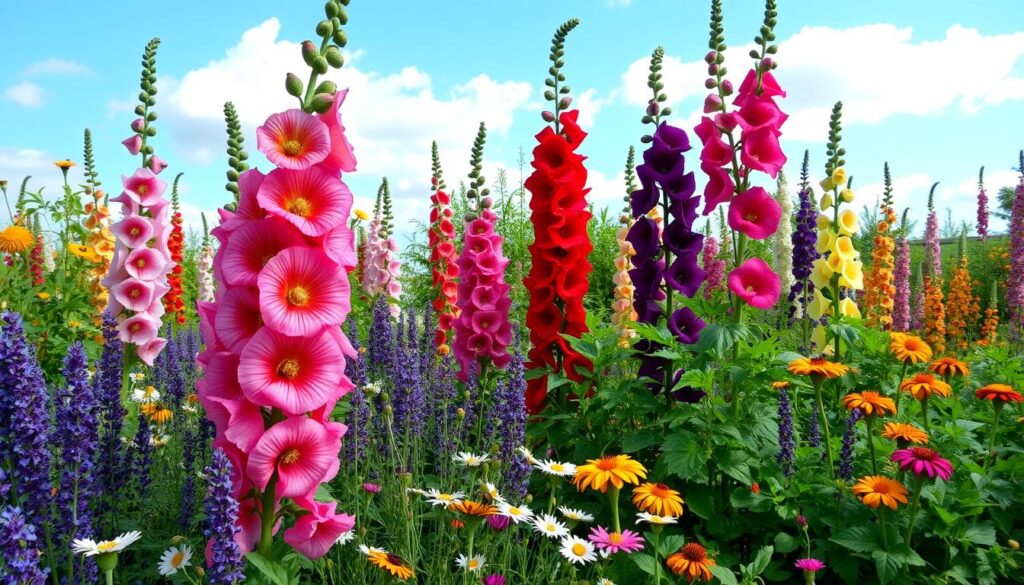
Finding the best plants to pair with hollyhocks means knowing how they grow and what they need. The right plants can make your garden look better and help each other grow.
Best Plant Pairings for Hollyhocks
Here are some great plants to grow with hollyhocks:
- Lavender – adds color and attracts bees and butterflies
- Catmint – grows tall and has pretty blue flowers
- Daylilies – add interest with their different blooming times
- Echinacea – helps attract more pollinators
Why Companion Planting Matters
Companion planting is more than just making your garden look good. Choosing the right plants can also make your soil better, keep pests away, and make your garden stronger.
| Companion Plant | Benefits for Hollyhocks |
|---|---|
| Lavender | Attracts beneficial insects, repels harmful pests |
| Catmint | Provides ground cover, reduces soil moisture evaporation |
| Daylilies | Creates visual layering, supports biodiversity |
“In nature, no plant grows alone. Companion planting mimics natural ecosystems, creating balance and beauty.”
By picking the right plants to grow with hollyhocks, you can make a garden that’s full of life and beauty. It will show off the stunning hollyhocks and help all the plants thrive.
Extending Hollyhock Lifespan
Gardeners who love hollyhocks want to keep their gardens beautiful for a long time. Learning how to care for hollyhocks can turn these flowers into lasting garden gems.
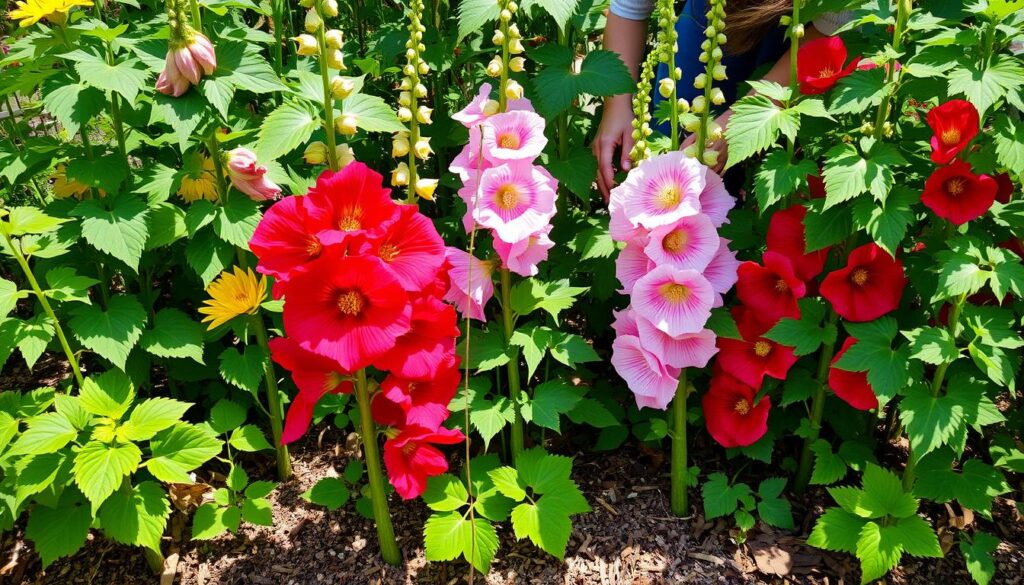
Hollyhocks are usually short-lived, but with the right care, they can bloom for many years.
Strategies for Perennial Success
- Protect root systems during winter with thick mulch layers
- Select hardy hollyhock varieties suited to your climate
- Ensure excellent drainage to prevent root rot
- Prune spent flowers to encourage continued blooming
Encouraging Re-Flowering
To keep hollyhocks blooming, you need to know their growth cycle. By using smart gardening tricks, you can make them bloom longer and stay healthy.
| Care Technique | Benefit |
|---|---|
| Regular deadheading | Stimulates additional flower production |
| Proper soil nutrition | Supports robust plant growth |
| Strategic seed collection | Ensures continuous garden population |
“With patience and proper care, hollyhocks can transform from short-lived beauties to perennial garden staples.” – Garden Enthusiast Magazine
Many gardeners find that knowing how to care for plants is crucial for growing hollyhocks. By giving them the right care and conditions, you can enjoy their beauty for years.
Pro tip: Collect and replant seeds from healthy, robust plants to maintain a continuous hollyhock display in your garden.
Common Problems with Hollyhocks
Growing hollyhocks can be rewarding, but they face challenges. Knowing these issues is key for successful care. With the right knowledge, you can prevent and manage most problems.
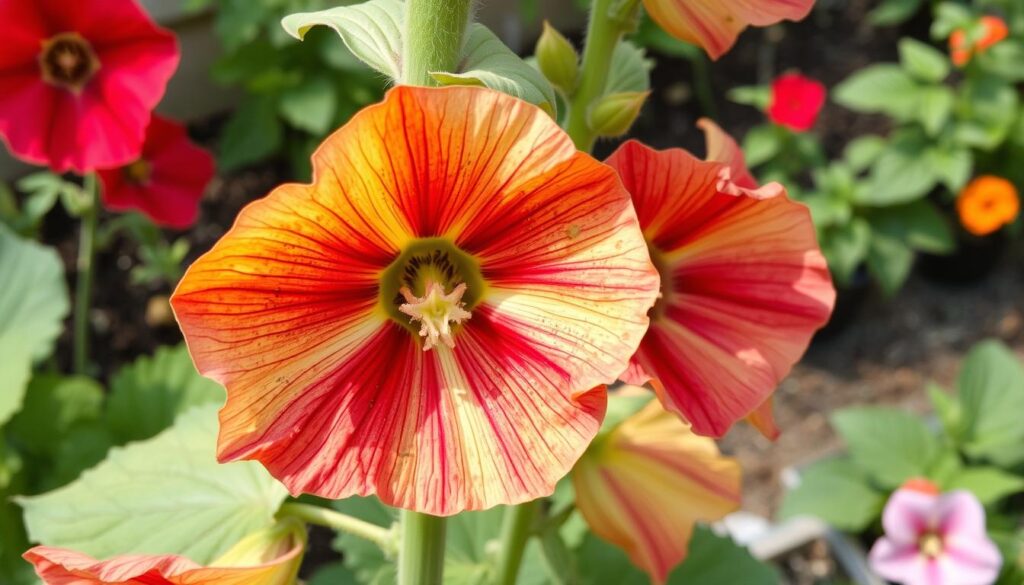
Hollyhocks are prone to several common garden problems. These can affect their health and look. Gardeners should watch their plants closely for any issues.
Identifying Common Diseases
- Powdery Mildew: A fungal disease that affects about 30% of hollyhocks, showing white powdery spots on leaves
- Rust Disease: Hits around 25% of plants, causing orange-brown spots on leaves
- Root rot in poorly drained soils, affecting about 12% of hollyhock plantings
Pest Management Strategies
Pest control is key for healthy hollyhocks. Aphids can cut flower yield by up to 20%. To protect your plants, you can:
- Regularly check plants for early signs of pests
- Use natural predators like ladybugs
- Apply organic pest control methods
Effective hollyhock care means knowing these challenges and taking steps to prevent them. By keeping soil right, ensuring air flow, and watching plant health, you can grow these beautiful flowers well.
“Prevention is always better than cure in garden management” – Garden Wisdom
With careful attention and quick action, you can beat most hollyhock problems. This way, you can enjoy a vibrant, healthy garden display.
Harvesting Seeds from Hollyhocks
Growing hollyhocks can be very rewarding. Learning to collect and save their seeds is key. This skill helps gardeners keep their favorite hollyhock varieties coming back year after year.
It’s important to know when to pick hollyhock seeds. Wait until the seed pods are brown and dry. They will open, showing dark seeds inside. Pick them when they’re dry but before they drop their seeds naturally.
Seed Collection Techniques
- Select mature, dry seed pods
- Cut entire flower stalks with dried pods
- Place pods in a paper bag to catch falling seeds
- Gently shake pods to release seeds
Proper Seed Storage Methods
After you’ve collected hollyhock seeds, it’s important to store them right. Keep them in a cool, dry spot in airtight containers. Make sure to label each container with the variety and when you collected them.
| Storage Condition | Recommended Practice |
|---|---|
| Container Type | Glass jar or sealed envelope |
| Temperature | Between 32-41°F |
| Humidity | Less than 50% |
| Seed Viability | 2-3 years with proper storage |
Learning how to collect seeds lets you keep your garden beautiful for years. It’s a way to connect with the past and keep your garden thriving.
*”Seed saving is an art that connects gardeners to generations of plant cultivation.”*
Conclusion: The Beauty of Hollyhocks in Your Garden
Growing hollyhock flowers can turn your garden into a stunning vertical landscape. These plants offer a chance to create dramatic displays that grab attention and help local ecosystems. With heights from 3 to 8 feet, hollyhocks make a great backdrop for any garden.
Starting your hollyhock journey can be both rewarding and interesting. About 60% of garden lovers successfully grow these flowers in well-drained soil and full sun. By choosing the right varieties and caring for them, you can enjoy blooms for 8 to 12 weeks. This attracts up to 15 different pollinators to your garden.
Why You Should Grow Hollyhocks
Hollyhocks are more than just beautiful plants – they’re garden art. They add beauty and help biodiversity in your garden. Whether you like classic pink, vibrant red, or elegant white, hollyhocks fit every style. Their versatility makes them a top pick for those who want beauty and ecological benefits.
Embracing Their Unique Charm
By growing hollyhocks, you’re joining a timeless garden tradition. Their tall height and wide color range can tell beautiful stories in your garden. Your garden will show off nature’s design, drawing admiration and helping local wildlife with each bloom.




